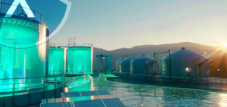Published on: April 17, 2025 / update from: April 17, 2025 - Author: Konrad Wolfenstein

White hydrogen-German energy coup in northern Bavaria: Natural hydrogen transforms the energy transition? - Image: Xpert.digital
Natural hydrogen could make imports superfluous: discovering a promising energy source
Bye-bye coal? Natural hydrogen in Germany - Gamechanger for industry?
Germany's energy landscape could face an important turning point. In northern Bavaria, researchers from the Friedrich Alexander University Erlangen-Nuremberg (FAU) have made a find that has the potential to revolutionize domestic energy supply: natural hydrogen, which can be obtained directly from the surface. This energy source, known as “white hydrogen”, could play an important role in the energy transition and Germany can bring a step closer to the independence of fossil fuels. The discovery is part of a growing number of finds worldwide and awakens hopes for previously unimagined energy sources directly under our feet, which could be used climate -neutral and sustainably.
Suitable for:
The surprising discovery in northern Bavaria
In August 2024, Master students from the FAU made a remarkable discovery as part of the research project “Natural Hydrogen in Northern Bavaria”. In the case of soil air measurements in carefully selected areas, they came across hydrogen concentrations that exceeded the upper measurement limit of their sensor of 1000 ppm. Felix Gsell, one of the students involved, described his first reaction as “a mixture of relief that I was not on the road for months without measuring anything at all, and doubts whether the high values are actually correct”.
The method for discovery was as simple as it was sweaty: With a hammer, the students hit a meter long drilling rod into the surface, introduced a probe that sealed the borehole, and then measured the concentration in the pumped soil air by means of a mobile hydrogen measuring device. The find is remarkable, since such high hydrogen concentrations have not been documented in the specialist literature during soil air measurements.
Such occurrences could also exist in other regions of Germany. The recent discoveries in the Haßbergen in northern Bavaria show that the inconspicuous forest floor actually contains hydrogen. These finds are part of a growing number of discoveries of natural hydrogen deposits worldwide.
What is natural hydrogen and how does it arise?
Natural or “white” hydrogen differs fundamentally from industrially generated hydrogen. While green hydrogen is obtained from fossil raw materials through electrolysis with the help of renewable energies or gray hydrogen, natural hydrogen occurs directly in deposits in the underground and is therefore a primary energy source.
The development of natural hydrogen in the earth's crust can be attributed to various geological processes. Processes in mountain trains play an important role, where there are chemical reactions due to plate tectonic activities. When folding mountains form because one continental plate pushes under another, rock gets into contact with water from the earth's mantle. A process referred to as “serpentine” takes place in which the minerals react in the rock and release hydrogen.
Geologists from the GFZ Helmholtz Center for Geof research in Potsdam have proven using computer simulations that the annual hydrogen generation capacity in mountains can be up to 20 times larger than on the bottom of the oceans. Especially in regions in which coat rocks originally lying deep inside the earth have reached the surface -close areas, optimal conditions for natural hydrogen development and large -scale accumulation of gaseous hydrogen could be available.
Geological requirements in Germany
The geological conditions in Germany offer potential for natural hydrogen deposits. While many previous finds have been made in mountain ranges such as the Pyrenees or the Alps, the discoveries in northern Bavaria show that other geological formations can also contain hydrogen.
Geologists suspect that hydrogen occurrence would also be possible in the German part of the Rhine grave, since the rocks could generally enable the origin and accumulation of hydrogen. The structure of the underground plays a crucial role - especially disturbances in the rock, i.e. breaks on which the surface is shifting and large tensions arise, can lead to the release of hydrogen.
Frank Zwaan from the GFZ explains that there are sometimes increased concentrations of hydrogen along such major disorders. These findings could help to search for further occurrence in Germany.
Comparison with international finds
The German finds are part of a global wave of discovery of natural hydrogen deposits. The currently largest known occurrence is located in Lorraine in French, near the German border. In Folkschviller in the Moselle department, scientists appreciate the hydrogen deposit at around 60 million tons. This discovery was also a random find: researchers originally searched for methane and instead found hydrogen, the concentration of which with increasing depth increase and at 1,200 meters already reached 20 percent.
Other important finds were documented in Mali, in the Bulqizë-Chrom mine in Albania and in the USA. In Albania, hydrogen emissions were monitored for over six years, with at least 200 tons of hydrogen being released annually - a minimum value, since the entire air volume of the mine was not recorded.
A US study in January 2025 caused a stir with the calculation that the global underground hydrogen deposits could exceed all previous ideas. The calculated amount contains about twice as much energy as is available in all known natural gas reserves on earth.
Meaning for Germany's energy future
The discovery of natural hydrogen occurrence could be of great importance for Germany's energy strategy. In its hydrogen strategy, the Federal Government determined the goal of building electrolysis capacities of ten gigawatts by 2030. Nevertheless, it is predicted that 50 to 70 percent of the required hydrogen must be imported.
Natural hydrogen could reduce this dependence on imports. In addition, white hydrogen has a decisive advantages over other forms: it does not have to be produced under high energy consumption and does not cause any CO₂ emissions during combustion-only water is created. This makes it an ideal, clean energy source for industry, traffic and electricity generation.
Especially for the steel industry, which is one of the largest CO₂ emitters in Germany, hydrogen could be a gamuchanger. Thyssenkrupp Steel in Duisburg is already planning to rebuild its steel production by 2045 and use hydrogen instead of coal. This could save around 3.5 million tons of CO₂ annually - one of the largest decarbonization projects worldwide.
Suitable for:
White hydrogen: the unsolved puzzles of the earth's crust
Despite the great potential, there are still considerable challenges. The origin and transport of white hydrogen in the earth's crust are not yet fully understood. Therefore, there are no sophisticated exploration strategies or reliable potential analyzes.
Another challenge lies in the form in which the hydrogen is present. Unlike natural gas, hydrogen does not always form great bubbles, but is often dissolved in the groundwater - “like gas that is solved in a bottle of champagne or a bottle of beer,” as the French researcher Jaques Pironon describes it.
It is also unclear which quantities can actually be promoted economically. Even if large occurrences are located, they could be enclosed too deep underground or away too far from the coast to be promoted profitably.
Infrastructure for a hydrogen economy
In parallel to research into natural occurrences, Germany is driving the structure of a hydrogen infrastructure. In April 2024, the German Bundestag approved a 9,700 kilometer -long hydrogen pipeline network, which is intended to combine the centers of hydrogen production with the high -demand industrial sectors. This network is designed as a backbone of the country's new energy statrix and is to be completed by 2032, possibly by 2037.
In addition, the Federal Ministry of Digital and Transport (BMDV) is investing in the construction of decentralized innovation and technology centers hydrogen (ITZ-H2). In March 2025, Federal Minister Volker Wissing presented funding notices of 154 million euros to representatives of the Chemnitz locations and the North German cluster from Bremen, Bremerhaven, Hamburg and Stade.
Hydrogen as the key to the energy transition
Natural hydrogen could make an important contribution to the energy transition in Germany. As a climate-neutral and practically inexhaustible energy source, it offers the potential to replace fossil fuels in many areas and drastically reduce CO₂ emissions.
The current discoveries in northern Bavaria are only the beginning of a more intensive search for natural hydrogen deposits in Germany. Further research projects will follow to record the full potential of this resource and to develop methods for economic support.
But even if the natural occurrences are promising, Germany will continue to rely on a mix of domestic production, imports and synthetic fuels. The Federal Environment Agency emphasizes: "Hydrogen will play an important role in the future energy supply. It is needed as a directly used final energy carrier, e.g. in the steel industry, or as a secondary energy source to produce hydrocarbons for aircraft."
The vision of Jules Vernes from 1870 - "The energy of tomorrow is water that has been disassembled by electrical current" - could partly become reality in a surprising turn: the energy of tomorrow could actually be hydrogen - not only generated artificially, but also gained directly from nature.
Natural hydrogen in Germany: a climate -neutral energy source with potential
The discovery of natural hydrogen occurrence in Germany marks an important milestone in the search for sustainable energy sources. While research is still at the beginning, the finds in northern Bavaria show the enormous potential of this resource. With further studies and technological advances, natural hydrogen could make a significant contribution to the energy transition and Germany help to achieve its climate goals. The coming years will show whether the white hydrogen will actually become the “new oil” - only this time climate -neutral and almost inexhaustible.
Suitable for:
Your partner for business development in the field of photovoltaics and construction
From industrial roof PV to solar parks to larger solar parking spaces
☑️ Our business language is English or German
☑️ NEW: Correspondence in your national language!
I would be happy to serve you and my team as a personal advisor.
You can contact me by filling out the contact form or simply call me on +49 89 89 674 804 (Munich) . My email address is: wolfenstein ∂ xpert.digital
I'm looking forward to our joint project.













